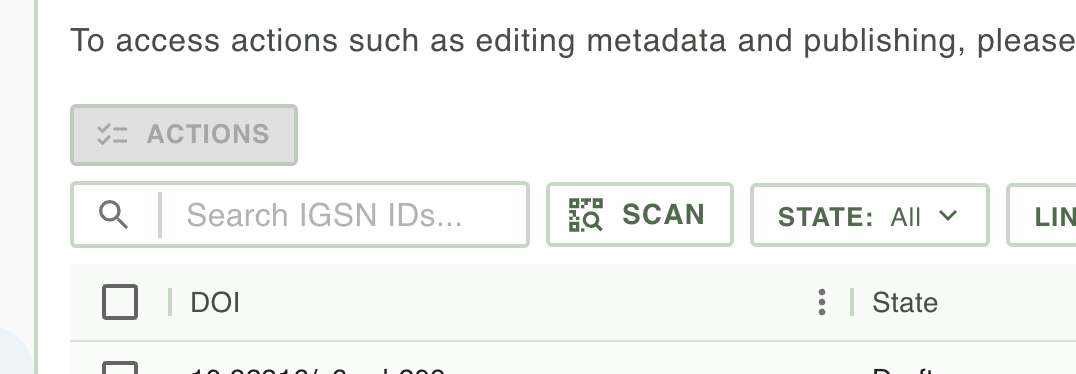Add IGSN IDs to your Inventory Items 🧪
Introduction
IGSN IDs
IGSN IDs are persistent and unique identifiers ("PIDs") for physical samples. By associating an IGSN ID with a sample, you enable transparency and traceability between research objects. This is achieved by providing a publicly accessible web page that contains the sample metadata, serving as a unique "source of truth" when referencing the sample in research outputs.
The IGSN ID metadata also describes relationships between the resource and other related materials, such as projects, institutions, people, and research outputs; it can also be used to identify an individual sample, a group of samples, or to a feature-of-interest (a collection site for samples). To learn more, see About IGSN IDs for Material Samples.
DataCite Integration
Research Space is now a DataCite Registered Service Provider, and the first to provide IGSN ID creation and registration services! DataCite provides a IGSN ID registration service through their DOI infrastructure, and a global PID Graph search interface through DataCite Commons. By integrating seamlessly with the DataCite API, we provide support for IGSN IDs and enable institutions to create, publish and update the IGSN ID metadata all without leaving RSpace Inventory.
By connecting to an existing institutional DataCite repository through the DataCite API, we ensure that the institution retains full ownership and control over their repositories: the repository is always managed by the institution, with RSpace Inventory only accessing the repository to perform IGSN-related actions.
Try it out
If you are a Team or Enterprise customer, you can use the integration after becoming a DataCite member and configuring the integration. See Configure DataCite IGSN IDs in Inventory (for System Administrators).
You can request credentials for test servers from DataCite, if you wish to try the integration out on your own RSpace server first. Alternatively, you can use the shared Inventory Test Server to preview the functionality provided.
Features
Overview
The DataCite documentation provides extensive information on the functionality, metadata format, and use cases of IGSN IDs. We recommend reviewing DataCite's Getting Started with IGSN IDs guide to start.
The following describes how we've implemented the integration.
IGSN identifiers can be in one of three states, which correspond to DataCite DOI states:
- Draft: a newly created IGSN ID without any public metadata
- An Inventory item will start without any PIDs.
- When a user reserves an IGSN ID for an item, DataCite provides a IGSN ID for the item in Draft state, but no metadata about the item is sent from RSpace to DataCite.
- Reserving an IGSN ID enables the metadata entry section, where users can fill in IGSN ID metadata fields they intend to make public.
- A Draft IGSN ID can be deleted, as it's not yet part of the global handle system.
- The preview page of a Draft IGSN will display any currently set ROR data
- Findable: a published, searchable IGSN ID with a public landing page
- After all mandatory IGSN ID fields have been completed, the user can publish the IGSN ID to make the metadata publicly accessible and searchable.
- RSpace generates a persistent landing page for the sample that includes all IGSN ID metadata for the item, and sends the metadata and landing page URL to DataCite.
- DataCite registers the IGSN ID with the global handle system, indexes the IGSN ID in DataCite Commons and the DataCite APIs, and sets the IGSN ID to resolve to the RSpace landing page.
- This IGSN ID is the unique and persistent identifier for this item, and can be used in citations to reliably reference the item.
- Any ROR data currently set on the RSpace instance is sent to DataCite as part of publication. ROR data does not change for published IGSNs, even if the RSpace instance changes its ROR settings.
- Registered: an IGSN ID that has been retracted from public access
- An IGSN ID that is Findable can be set to Registered to hide the item and its associated metadata from public access, in case the wrong item was published.
- Note that the Members API can still be used to access this item, so please take care before publishing that all the information is to be made public.
- Rectracting an IGSN removes any ROR data from DataCite. Current ROR data will be available on the preview page for the IGSN in RSpace.
Available features
We focus on providing support for the core DataCite IGSN ID lifecycle:
- Create Draft IGSN ID
- Populate mandatory metadata
- Populate recommended fields:
- Subject
- Description
- Date
- Alternate Identifier
- Geolocation
- Publish & generate persistent landing page
- Make metadata updates and publish again
- Retract a published IGSN ID
- Delete an IGSN ID draft
- Preview landing page
- Associate a ROR ID
Create an IGSN ID
RSpace offers two flexible approaches for creating and managing IGSN IDs: Automatically Linked IGSN IDs and Pre-registered IGSN IDs.
Automatically Linked IGSN IDs
This approach begins with an existing inventory item—whether a sample, subsample, or container—and creates an IGSN ID directly from the item's Identifiers section. When you create an IGSN ID this way, the metadata fields are automatically populated with information from your inventory item, streamlining the setup process. This workflow is ideal for existing samples that need persistent identifiers for citation or reference purposes.
RSpace reserves an IGSN ID in Draft state and associates it with an RSpace Inventory item. IGSN ID metadata will be available to fill out in RSpace, but the metadata and identifier are not made public at this stage.
The Draft IGSN ID can be deleted, or published to explicitly make the metadata publicly accessible.
To create an automatically linked IGSN ID:
- Open the Identifiers section on a sample, subsample, or container
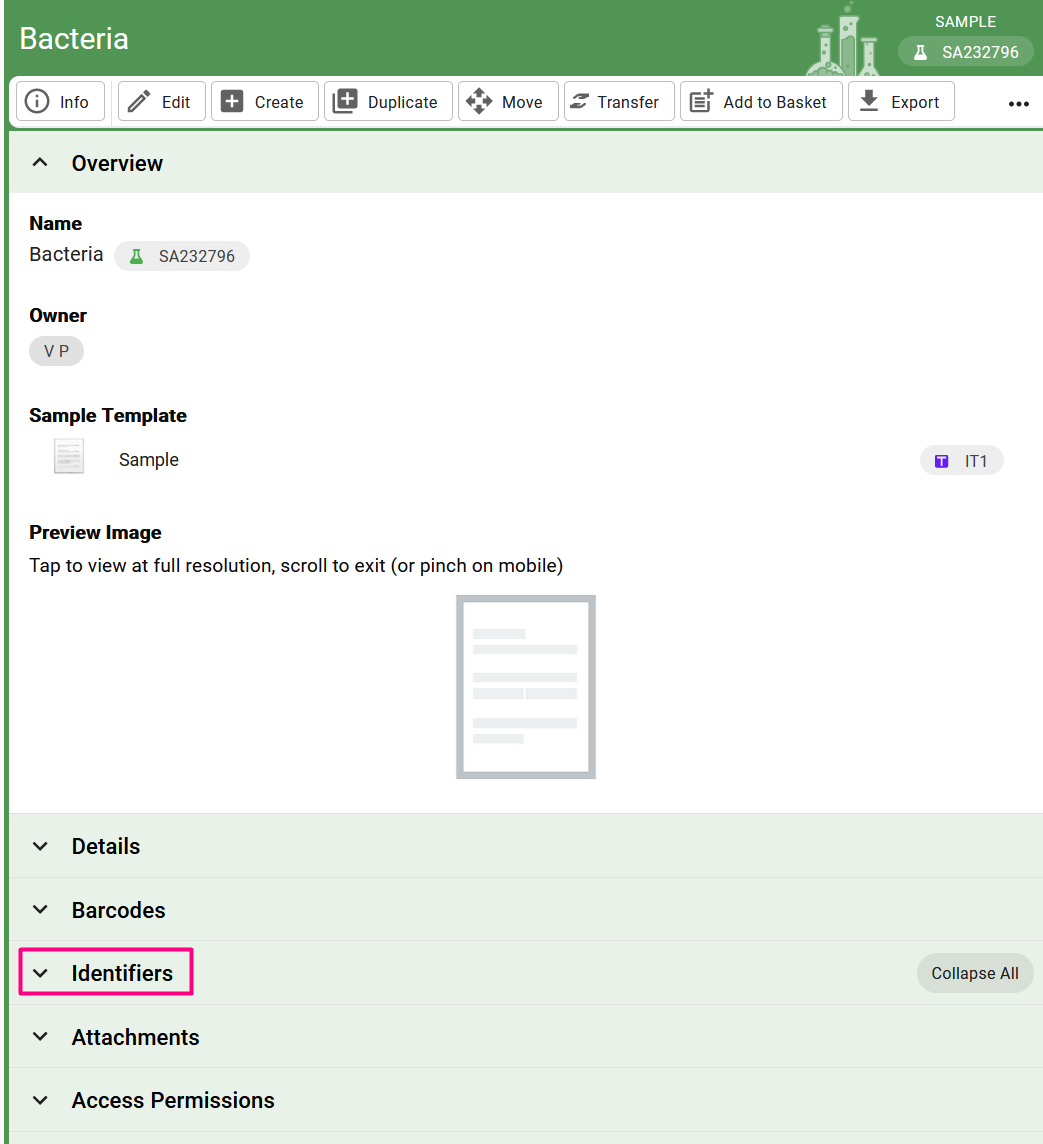
- Press the "Create new IGSN ID" button to create an IGSN ID. Each Inventory item can only be assigned 1 IGSN ID. Note that if you are in the process of creating a new item, you will need to save the item first before being able to create an IGSN ID for it.
 If you get a "The Identifier could not be created. IGSN integration is not enabled on this RSpace instance." error, please contact your System Administrator.
If you get a "The Identifier could not be created. IGSN integration is not enabled on this RSpace instance." error, please contact your System Administrator. - The identifier section now shows the Draft IGSN ID and its metadata fields. Required fields have been pre-populated with default values.RSpace does not send metadata to DataCite when an IGSN ID is in Draft state, the metadata is only made public when publishing the IGSN ID.

Pre-registered IGSN IDs
This approach allows you to create IGSNs independently of Inventory items, with the intention of linking them to Inventory items later in your workflow. This method is particularly useful for planning sample collection or batch preparation activities, making it ideal for pre-planning research projects, preparing for fieldwork, or situations where you need persistent identifiers before physical samples exist.
To create an IGSN ID in this manner, go to the "IGSN IDs" section of Inventory by tapping the Sidebar button.

Then tap the "Bulk Register" button. This dialog will then ask for you for a number of IGSN IDs to create. Once submitted, those new IGSNs can be seen in the table below.
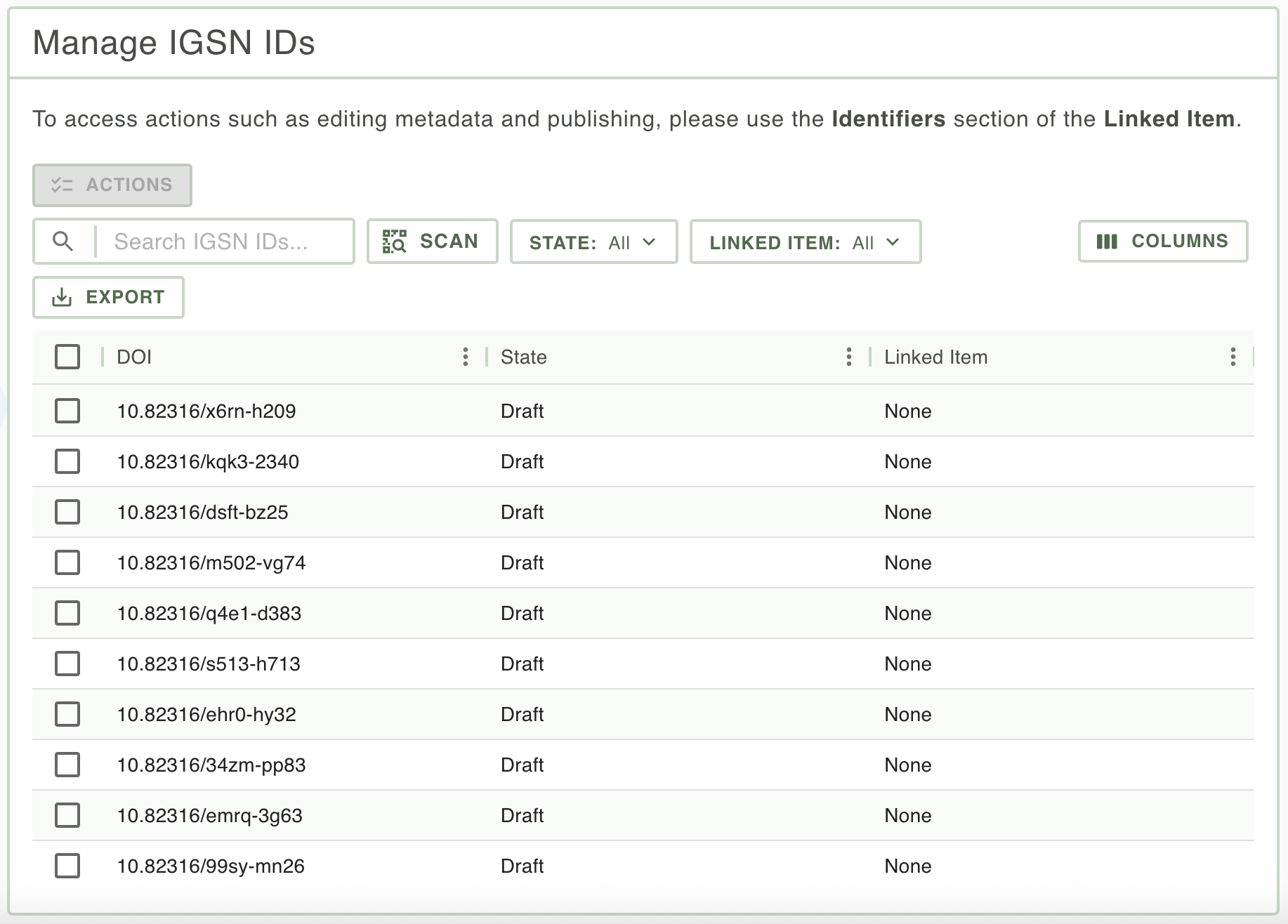
Later, to then link a pre-created IGSN ID with an Inventory item, find the item in Inventory and under its "Identifiers" section tap the "Link existing IGSN ID" button. This will open a dialog with the same table from which you can select the IGSN ID.

Edit IGSN ID metadata
- Click on Edit when viewing an item

- Scroll to the Identifiers section, and make the required edits, or add recommended fields.

- Save to confirm the changes.

Geolocations
You can associate various geolocation data with each IGSN. The specification for how this data is captured is quite complex, so here's an overview.
Format options
First, each geolocation can be described using one or more methods: as a point, a description, a box, and/or a polygon.

All longitudes and latitudes use decimal degrees rather than minutes and seconds, so any decimal value between -90.0 and 90.0 inclusively for latitudes, and -180.0 and 180.0 inclusively for longitudes, is valid.
- The point is a single longitude and latitude pair. Both values need to be set to define a point.
- The description is a textual description of the place. A sample may have been collected at a particular site, with the site's location described by the other geolocation properties, while the address is included here.
- The box is a region defined by four bounds, in each of the cardinal directions. This is useful for describing approximate regions, again, using decimal degrees.
- The polygon method provides a mechanism for accurately describing a region based on a series of vertices. The first and last points are always the same, enclosing an area. For the avoidance of any ambiguity, an additional point within the enclosed region can also be specified, but this is only really necessary when it may not be obvious whether the region is the area inside the points, or the rest of the Earth.

Preview map
The point, box, and polygon are shown on a map both in Inventory and on the public page, alongside the numerical coordinates, to make it easier to visualise the location being described. Points are shown as a blue circle, with the precise point being at the circle's center. Boxes are shown as red rectangles, and the polygons are shown in orange.
The partial screenshot below shows a point at the Royal Observatory and a region of Greenwich park by means of a bounding box.
Note that you can pan the map by clicking and dragging, and use the plus and minus icons to zoom in/out. You can also temporarily toggle the visibility of various data on the map, by using the toggles below it (the selection resets once you refresh a page).

Publishing geolocations
Each geolocation entry needs to be defined by at least one of these methods, but can also be described by all four. Multiple geolocation entries can be added to the same IGSN, and the methods they use to describe a location can be different.
Once one or more of these methods of defining geolocation data have been specified, for as many locations as desired, the IGSN can be published. Whilst the Inventory item with the IGSN can be saved at any time, if the geolocation data is invalid, e.g. a coordinate is missing or outside of the valid range, then the IGSN cannot be published.
Include Inventory metadata
Various metadata associated with the item in Inventory, but not part of the IGSN schema, can be included on the IGSN landing page to provide a comprehensive, domain-specific record of the item. This includes description, tags, the custom fields as populated from the template, and any extra fields that have been added to the item.
- To include these fields on the public page, simply check the box labelled "Include custom fields and general item metadata on landing page?".
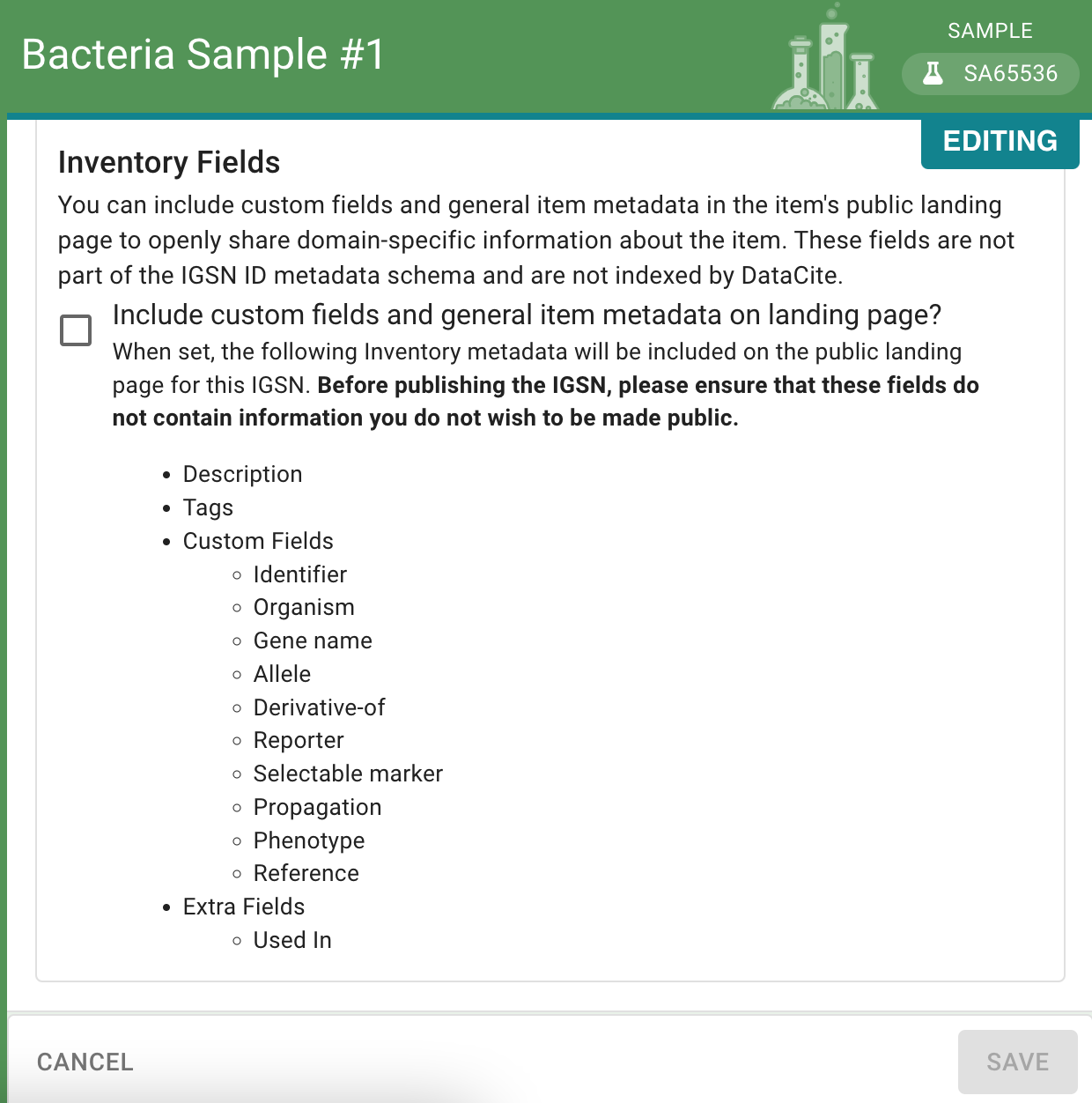
- To set these changes live, Preview the updated landing page to make sure you are happy with the fields that will be made public, then Publish or Republish the item.
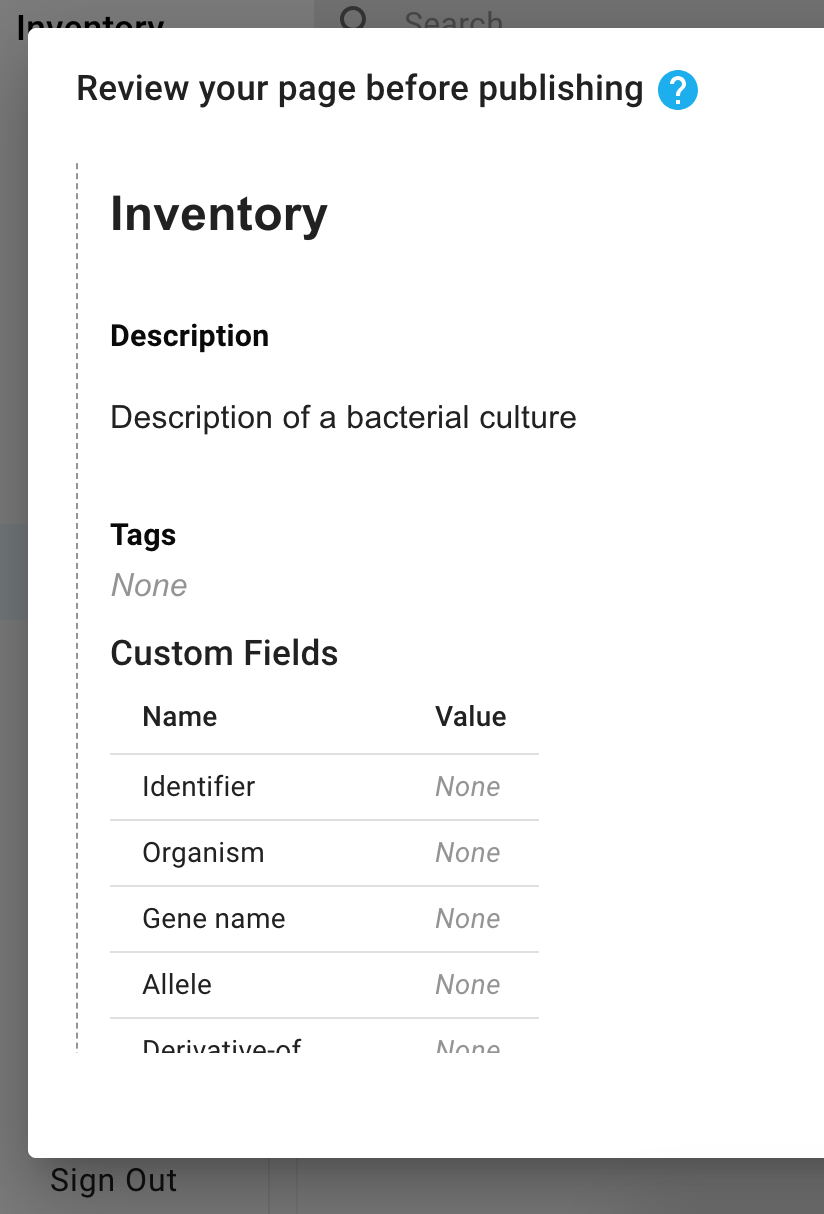
- The fields will now be visible on the public page, and within the preview dialog going forward. Note that any updates to these fields will not automatically show on the public page, as the IGSN must be republished first.
Publish an IGSN ID
Publishing sets the IGSN ID state to Findable on DataCite. The IGSN ID and its metadata, alongside a landing page generated by RSpace, will be made publicly accessible through DataCite Commons and DataCite APIs. A persistent, citable IGSN ID URL will be created, pointing to the landing page.
After publishing, the IGSN ID cannot be returned to a Draft state. Changing the state to Registered keeps the metadata visible to other DataCite Members via the Member API.
See DataCite DOI States for more information.
To publish an IGSN ID:
- Click on Publish in the Identifiers section. The button is only enabled if all required fields are filled in.

- The state of the IGSN ID changes to Findable. A persistent and public landing page is generated and hosted by RSpace. The IGSN ID redirects to this landing page, providing a stable URL that can be used to share and reference this item.
A direct link to the RSpace landing page is also provided for convenience, but the IGSN ID should be used in public references to the item.
Update an IGSN ID
Any IGSN ID metadata changes you make in RSpace are not made public until you explicitly publish them. We recommend only updating an IGSN to provide additional metadata, or to correct any errors.
If the item has been modified significantly enough to exhibit different properties, you need to decide whether it is important for you that an IGSN ID always points to a specific version of the item, e.g. if the IGSN ID is going to be referenced in a paper. If so, we recommend creating a separate item in RSpace, assigning it a new IGSN ID, and clearly indicating the link between the historical and new item in their metadata.
To update an IGSN ID:
- Make required changes to the IGSN ID metadata fields
- Click on Republish
- The landing page will now reflect the latest version of the metadata
Delete an IGSN ID
Deleting removes the IGSN ID and its association with this item.
To delete an IGSN ID:
- Click on Delete in the Identifiers section.

- The IGSN ID is deleted and removed from the section.
A new Draft IGSN ID can be created and associated with the item in the future, whether the item had a Draft IGSN ID previously or not. However, only one IGSN ID can be associated with an item at any one time.Deleting an IGSN ID also removes all metadata you might have filled in, therefore we recommend only deleting an IGSN ID if you are confident this item will not require one for the time being.
Retract an IGSN ID
Click on Retract to change a Findable IGSN ID into a Registered IGSN ID. This will remove the IGSN ID from DataCite Commons and the DataCite Public API, as well as display no metadata on the landing page. Keep in mind the Member API can still be used to access historical metadata about the item.
If you wish to have the sample be public again, you can publish it to turn it back to Findable.
Bulk Operations
From the IGSN IDs page (accessible through the "IGSN IDs sidebar button), IGSN IDs can be operated on in a bulk manner. Filter the table using the state and associated filters, select a number of IGSNs, and choose from the Actions menu.
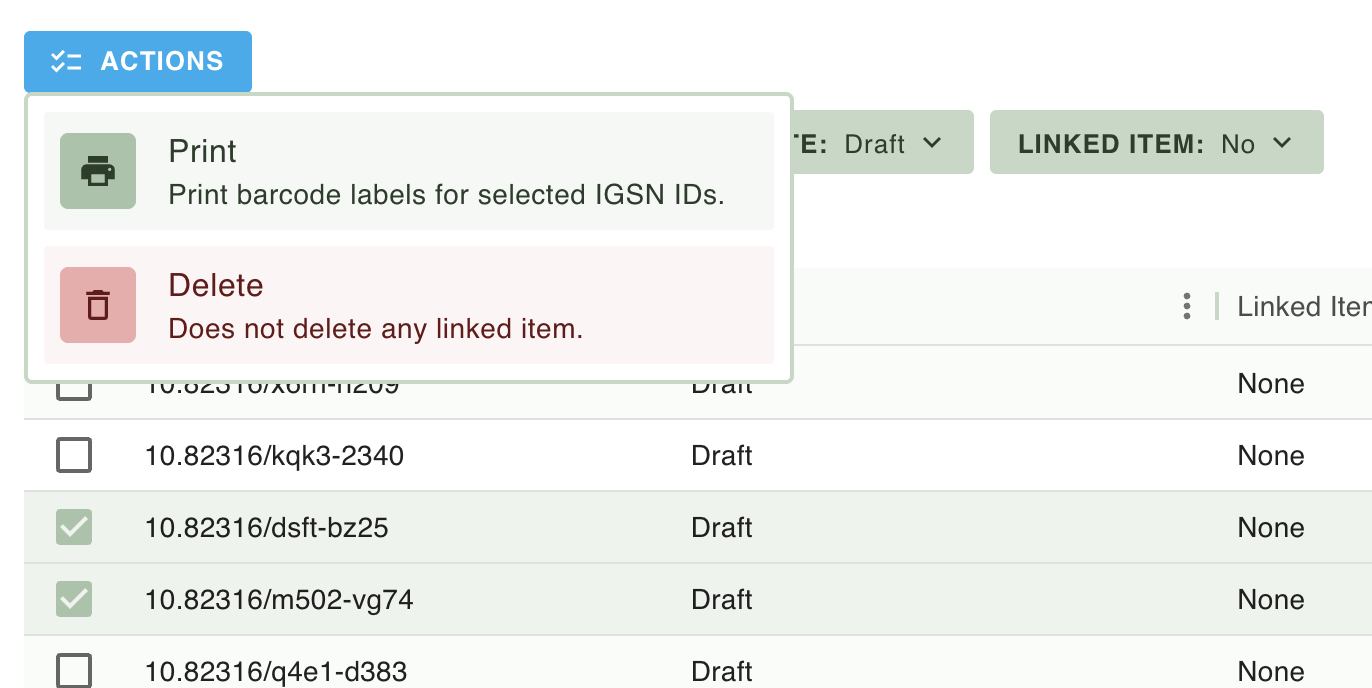
For more information on printing, see Scan, Use and Print Barcodes in Inventory 🧪
The IGSN ID management interface includes both a search box and barcode scanner functionality to help you quickly locate specific IGSNs. The search box allows you to find IGSNs by entering just a few characters of the IGSN ID, while the barcode scanner is particularly useful when you have a physical sample with its printed barcode label at hand but need to locate the corresponding digital record in the system.
